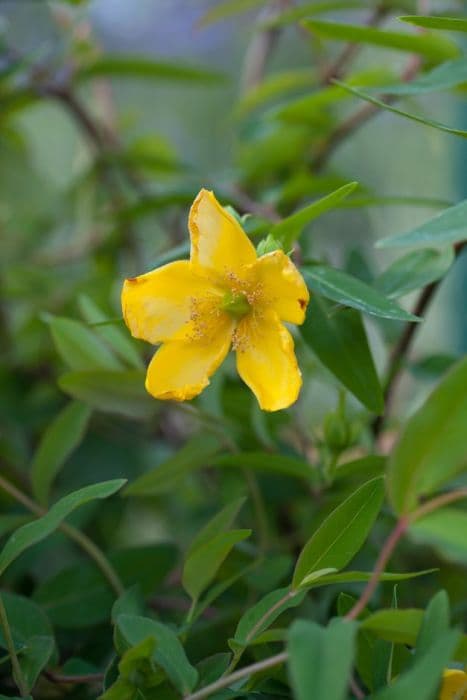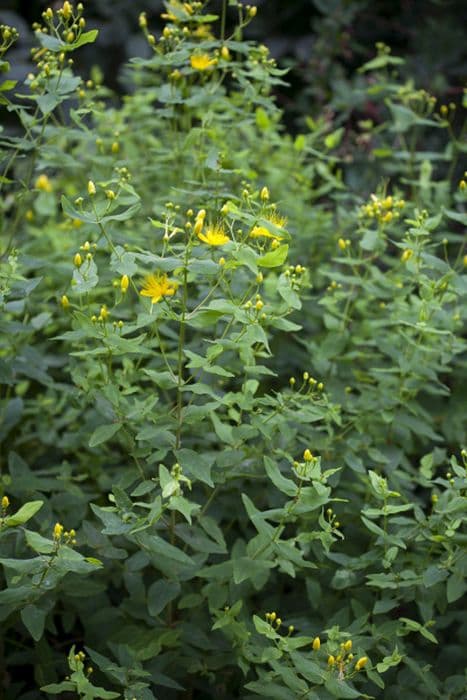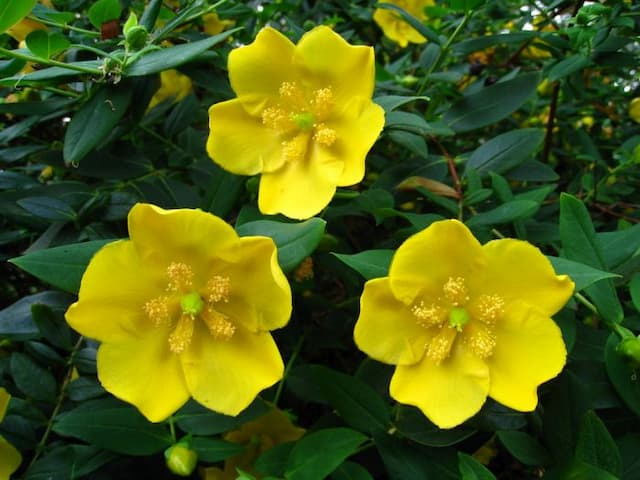St. John's Wort Hypericum Miracle Blossom = 'Allblossom' (PBR) (Miracle Series)

ABOUT
Hypericum Miracle Blossom, belonging to the Miracle Series, is a striking perennial plant known for its beautiful ornamental features. It is a standout in the garden with a profusion of vibrant yellow flowers that are rich in color and have a bushy appearance. The blossoms have a distinctive shape; each bloom typically comprises numerous stamens that create a showy, fluffy center, surrounded by five petals that radiate outwards. The foliage of Hypericum Miracle Blossom is also noteworthy, with bright green leaves that form a lush backdrop to the vivid flowers. The leaves are elliptical in shape and have a smooth, glossy surface which can sometimes appear to have a slightly blue tinge, contrasting nicely against the warm yellow of the blossoms. The stems of the plant are woodsy and supportive, allowing the plant to maintain a robust form as the flowers and leaves grow in ample clusters. Further adding to its ornamental appeal, some Hypericum varieties can also produce colorful berries that follow the flowering season, although specifics about Hypericum Miracle Blossom 'Allblossom's berry production are not detailed in this description. Overall, Hypericum Miracle Blossom is a visually appealing plant that is popular for its bright yellow blooms which can be a delightful sight in gardens, providing a pop of color throughout their blooming season.
About this plant
 Names
NamesFamily
Hypericaceae.
Synonyms
St. John's Wort, Rose of Sharon.
Common names
Hypericum 'Allblossom', Hypericum x inodorum 'Allblossom'.
 Toxicity
ToxicityTo humans
St. John's Wort, which is the common name for Hypericum, is generally considered to have a low toxicity profile for humans. However, ingesting large amounts can potentially cause adverse reactions. Some people may experience gastrointestinal symptoms such as nausea, vomiting, and diarrhea. Sensitivity to sunlight is another possible side effect, where the skin can become more prone to sunburn or other skin reactions when exposed to UV rays. In cases of severe ingestion, more serious symptoms can include confusion, dizziness, or even tremors. If you suspect poisoning, it is important to seek medical attention immediately.
To pets
St. John's Wort is known to be toxic to pets when consumed in large quantities. The toxicity symptoms in pets, similar to humans, can include gastrointestinal upset such as vomiting and diarrhea. It can also cause photosensitivity, where pets may develop skin irritation or burns when exposed to sunlight after ingestion. In severe cases, signs such as lethargy, restlessness, and complications in the nervous system could arise. If your pet has ingested this plant, it is important to contact a veterinarian as soon as possible.
 Characteristics
CharacteristicsLife cycle
Perennials
Foliage type
Deciduous
Color of leaves
Green
Flower color
Yellow
Height
2-3 feet (60-90 cm)
Spread
2-3 feet (60-90 cm)
Plant type
Shrub
Hardiness zones
5
Native area
Cultivar
Benefits
 General Benefits
General Benefits- Attractive Blooms: Hypericum Miracle Blossom produces an abundance of bright yellow flowers that enhance the aesthetic appeal of any garden or landscape.
- Drought Tolerance: Once established, this plant is relatively drought-tolerant, making it suitable for gardens in drier climates or regions with water restrictions.
- Low Maintenance: This plant requires minimal ongoing care, making it an excellent choice for both experienced gardeners and beginners.
- Versatile Placement: It can be used in flower beds, borders, and as ground cover or for mass planting, providing flexibility in garden design.
- Long Flowering Period: With a long blooming season stretching from early summer to early fall, it offers prolonged visual interest throughout the growing months.
- Attracts Pollinators: The bright flowers attract bees, butterflies, and other beneficial pollinators, helping to support local ecosystems.
- Deer Resistant: Hypericum Miracle Blossom is not a preferred plant for deer, thus reducing the risk of damage in areas with deer populations.
- Hardy Nature: It is known for its hardiness and ability to withstand cooler temperatures, making it suitable for a variety of climates.
 Medical Properties
Medical Properties- Hypericum perforatum, commonly known as St. John's Wort, which the Miracle Blossom plant resembles, is traditionally used for its antidepressant properties.
- St. John's Wort has been used for centuries in herbal medicine to help alleviate mild to moderate depression and anxiety.
- The active ingredients in St. John's Wort, such as hypericin and hyperforin, are believed to have a positive effect on mood-regulating chemicals in the brain.
- It may also be used topically in oil form for its antiviral and antibacterial properties to help heal minor wounds and burns.
- St. John's Wort is sometimes used to relieve symptoms of menopause such as mood swings and hot flashes.
- It has been used traditionally to treat nerve pain and to relieve symptoms associated with mild to moderate somatic pain.
 Air-purifying Qualities
Air-purifying QualitiesThis plant is not specifically known for air purifying qualities.
 Other Uses
Other Uses- Photography Prop: Hypericum 'Miracle Blossom' can be used as an attractive backdrop or focal point in garden photography due to its showy flowers and berries.
- Natural Fabric Dye: The bright-colored berries can be crushed to produce a natural dye for fabrics, offering a range of colors from yellow to reddish tones.
- Crafts and Decorations: Dried branches of Hypericum 'Miracle Blossom' can be used in floral arrangements, wreaths, or as part of craft projects for their structural beauty.
- Insect Home: When left unpruned in the garden, the dense shrub can provide shelter for beneficial insects and small wildlife.
- Educational Tool: Gardeners and educators can use the plant to demonstrate propagation techniques, such as cuttings, to new horticulturists.
- Photosensitive Chemical Source: The plant can potentially be used to extract hypericin, a compound of interest in the field of photography for its photosensitive properties (not for consumption or medical use).
- Garden Borders: With its compact growth habit, Hypericum 'Miracle Blossom' can be used to create defined borders in a garden or along walkways.
- Natural Confetti: The petals of the Hypericum 'Miracle Blossom' can be dried and used as biodegradable confetti for outdoor celebrations.
- Seasonal Displays: The striking berries and flowers can be incorporated into fall and winter displays, adding natural color and interest.
- Tattoo Design Inspiration: The distinctive flowers and berries can inspire tattoo designs for those looking for botanical-themed body art.
Interesting Facts
 Feng Shui
Feng ShuiThe plant Hypericum, commonly known as St. John's Wort, is not traditionally used in Feng Shui practice.
 Zodiac Sign Compitability
Zodiac Sign CompitabilityThe plant Hypericum, commonly known as St. John's Wort, is not used in astrology practice.
 Plant Symbolism
Plant Symbolism- Protection: Hypericum, also known as St. John's Wort, has a reputation for warding off evil spirits and negative energy. In ancient times, it was often hung over religious icons or carried as a talisman for protection.
- Good Health: Due to its medicinal properties, especially in treating depression and wounds, St. John's Wort is also associated with healing and good health.
- Happiness and Positivity: The bright yellow flowers of the plant are symbolic of sunshine and joy, bringing a message of optimism and lifting the spirits.
- Strength and Resilience: It is a hardy plant that can survive in challenging conditions, symbolizing the ability to endure difficult times with courage.
 Water
WaterThe St. John's Wort should be watered regularly but allow the top inch of soil to dry out between watering sessions. It is generally best to water this plant deeply once a week, depending on the weather and soil conditions. Use about 1 gallon of water for an established plant, ensuring the water reaches deep into the root system without leaving the soil waterlogged. During hot, dry spells, the frequency may increase to twice a week. Over winter, reduce watering to every other week or less, just enough to prevent the soil from completely drying out.
 Light
LightSt. John's Wort thrives in a location that receives full sun to partial shade. Ideally, it should get at least 6 hours of direct sunlight daily, which encourages plentiful blooms and healthy growth. However, in extremely hot climates, a spot that offers afternoon shade can help protect it from intense, potentially harmful sun exposure.
 Temperature
TemperatureSt. John's Wort performs best in temperatures between 50°F and 90°F. It can survive minimum temperatures down to around 0°F, but ideally, it should not be exposed to prolonged periods of cold below 10°F. In contrast, this plant can typically tolerate high temperatures, but extended periods over 90°F may necessitate additional watering and care.
 Pruning
PruningPrune St. John's Wort in early spring to encourage bushy growth and more flowers. Remove any dead or damaged branches and cut back about a third of the oldest stems to ground level to rejuvenate the plant. Pruning is usually required annually for maintaining plant shape and promoting vigorous, healthy growth.
 Cleaning
CleaningAs needed
 Soil
SoilThe best soil mix for the St. John's Wort 'Allblossom' (common name) should be well-draining with a high content of organic matter such as compost or peat moss. A balanced mixture could be one part garden soil, one part compost, and one part perlite or coarse sand to aid drainage. This plant prefers slightly acidic to neutral pH, ranging from 5.5 to 7.
 Repotting
RepottingSt. John's Wort 'Allblossom' should be repotted every 2 to 3 years or when it has outgrown its current pot. Springtime is ideal for repotting to give the plant a chance to establish in the new soil before the growing season.
 Humidity & Misting
Humidity & MistingSt. John's Wort 'Allblossom' is adaptable and does not require high humidity; average household humidity levels are usually sufficient for this plant. Around 40-60% relative humidity is ideal.
 Suitable locations
Suitable locationsIndoor
Place in bright, indirect light and water when topsoil is dry.
Outdoor
Plant in full sun to partial shade; water regularly.
Hardiness zone
5-9 USDA
 Life cycle
Life cycleThe Hypericum Miracle Blossom, commonly known as St. John's Wort, begins its life cycle as a seed, which upon germination, develops into a seedling with its first true leaves. It then enters the vegetative stage, where it grows stems and leaves in preparation for flowering, a process that is fostered by warm temperatures and adequate sunlight. During the flowering stage, the plant produces distinctive bright yellow flowers that are characteristic of the genus Hypericum. After pollination, which can be facilitated by insects, the plant forms fruit, typically a capsule containing numerous seeds, which mature and are eventually dispersed to conclude the reproductive stage. The plant can then enter a period of dormancy, especially in regions with colder climates, where growth ceases temporarily before the cycle begins anew with the next growing season. Some members of the Hypericum genus are perennial and will go through multiple life cycles over several years.
 Propogation
PropogationPropogation time
Spring to Summer
Propogation: The Hypericum Miracle Blossom, known more commonly as St. John's Wort, is typically propagated via softwood cuttings. This process is best done in late spring or early summer when the plant's growth is most vigorous. To propagate, a healthy, non-flowering shoot is selected and a cutting about 5 to 6 inches (approximately 12.7 to 15.24 centimeters) in length is taken with a sharp, clean tool. The lower leaves are stripped, and the cut end is dipped in a rooting hormone to encourage root development. The cutting is then planted in a well-draining soil mixture and kept moist until roots have developed, which usually takes a few weeks. The young plants are then gradually acclimatized to outdoor conditions before being transplanted into their final location. This method is efficient and helps to ensure that the new plants will bear the same desirable traits as the parent plant.









